HIV/AIDS: Global Outbreak, Transmission, and Impact Report
VerifiedAdded on 2022/08/31
|12
|2067
|24
Report
AI Summary
This report provides a detailed analysis of the HIV/AIDS outbreak, beginning with its origins and tracing its spread across the globe. It examines the epidemiological determinants and risk factors associated with the disease, including modes of transmission and the impact on affected communities. The report highlights the significant impact of HIV/AIDS on individuals, families, and broader societal structures, including economic and social networks. Furthermore, the report outlines the reporting protocols necessary to manage outbreaks and presents various strategies for prevention and intervention. Tables and figures are included to provide data on prevalence, mortality, and infection rates. The document emphasizes the importance of education and awareness, and underscores the need for early detection and intervention strategies to combat the spread of the disease.
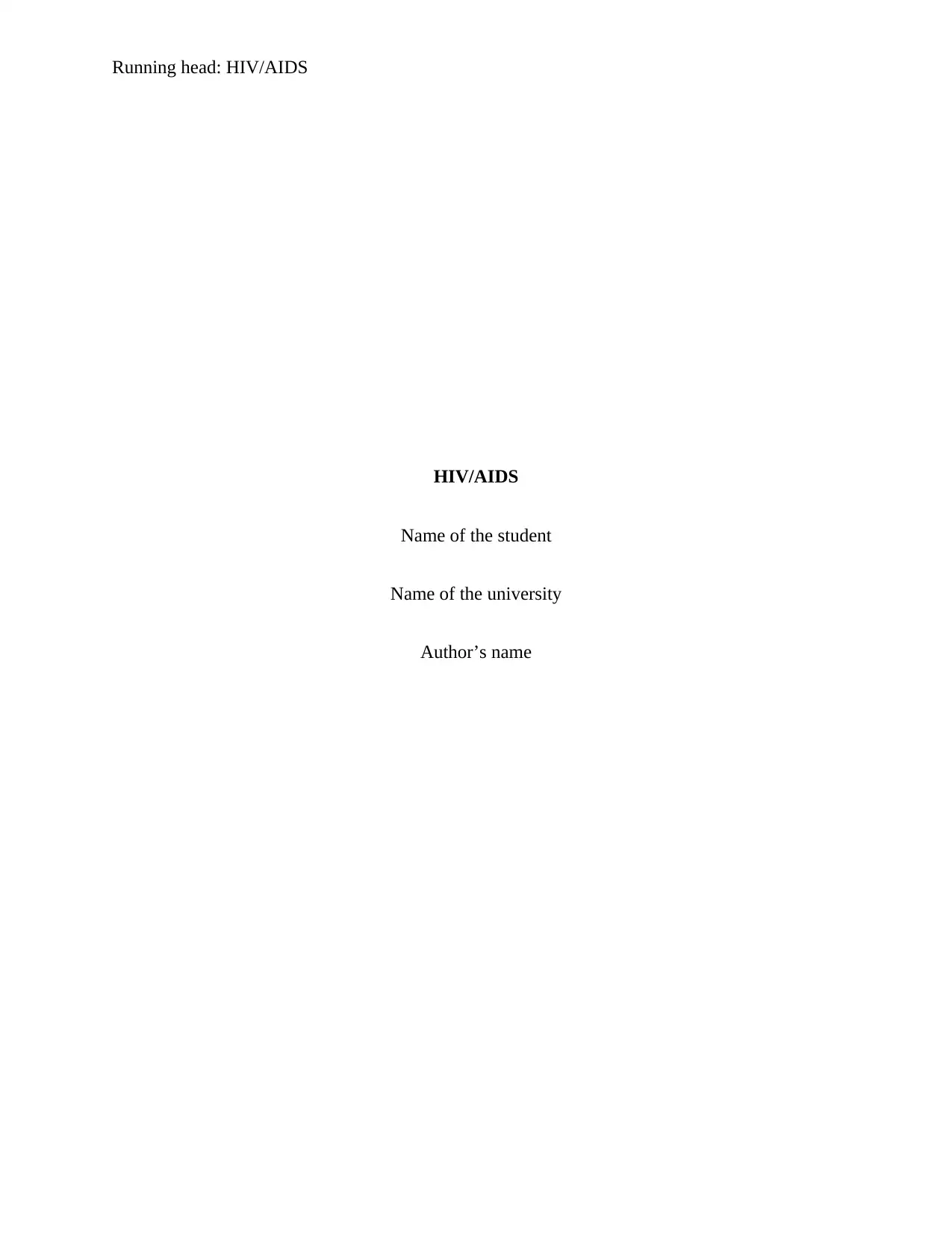
Running head: HIV/AIDS
HIV/AIDS
Name of the student
Name of the university
Author’s name
HIV/AIDS
Name of the student
Name of the university
Author’s name
Paraphrase This Document
Need a fresh take? Get an instant paraphrase of this document with our AI Paraphraser
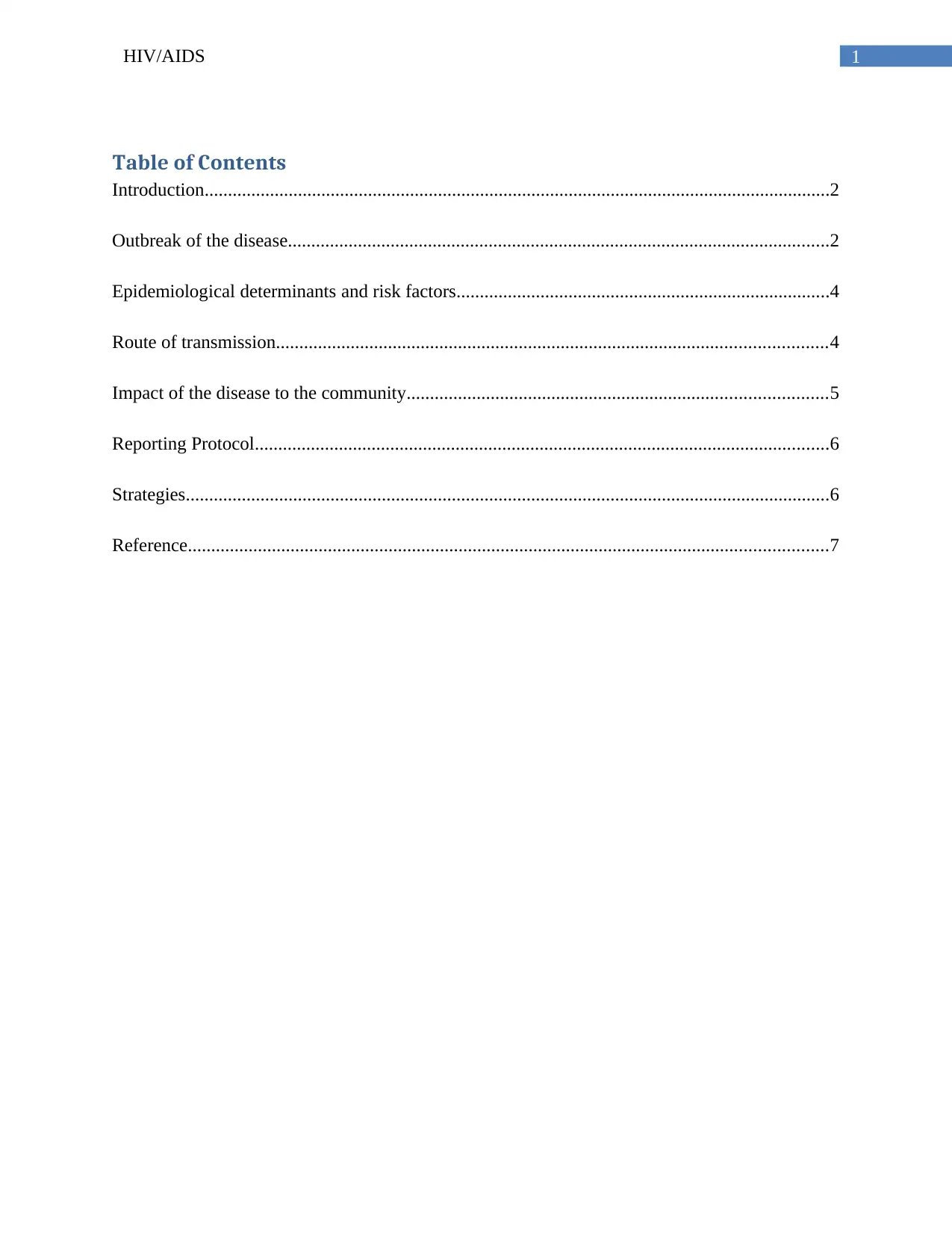
1HIV/AIDS
Table of Contents
Introduction......................................................................................................................................2
Outbreak of the disease....................................................................................................................2
Epidemiological determinants and risk factors................................................................................4
Route of transmission......................................................................................................................4
Impact of the disease to the community..........................................................................................5
Reporting Protocol...........................................................................................................................6
Strategies..........................................................................................................................................6
Reference.........................................................................................................................................7
Table of Contents
Introduction......................................................................................................................................2
Outbreak of the disease....................................................................................................................2
Epidemiological determinants and risk factors................................................................................4
Route of transmission......................................................................................................................4
Impact of the disease to the community..........................................................................................5
Reporting Protocol...........................................................................................................................6
Strategies..........................................................................................................................................6
Reference.........................................................................................................................................7
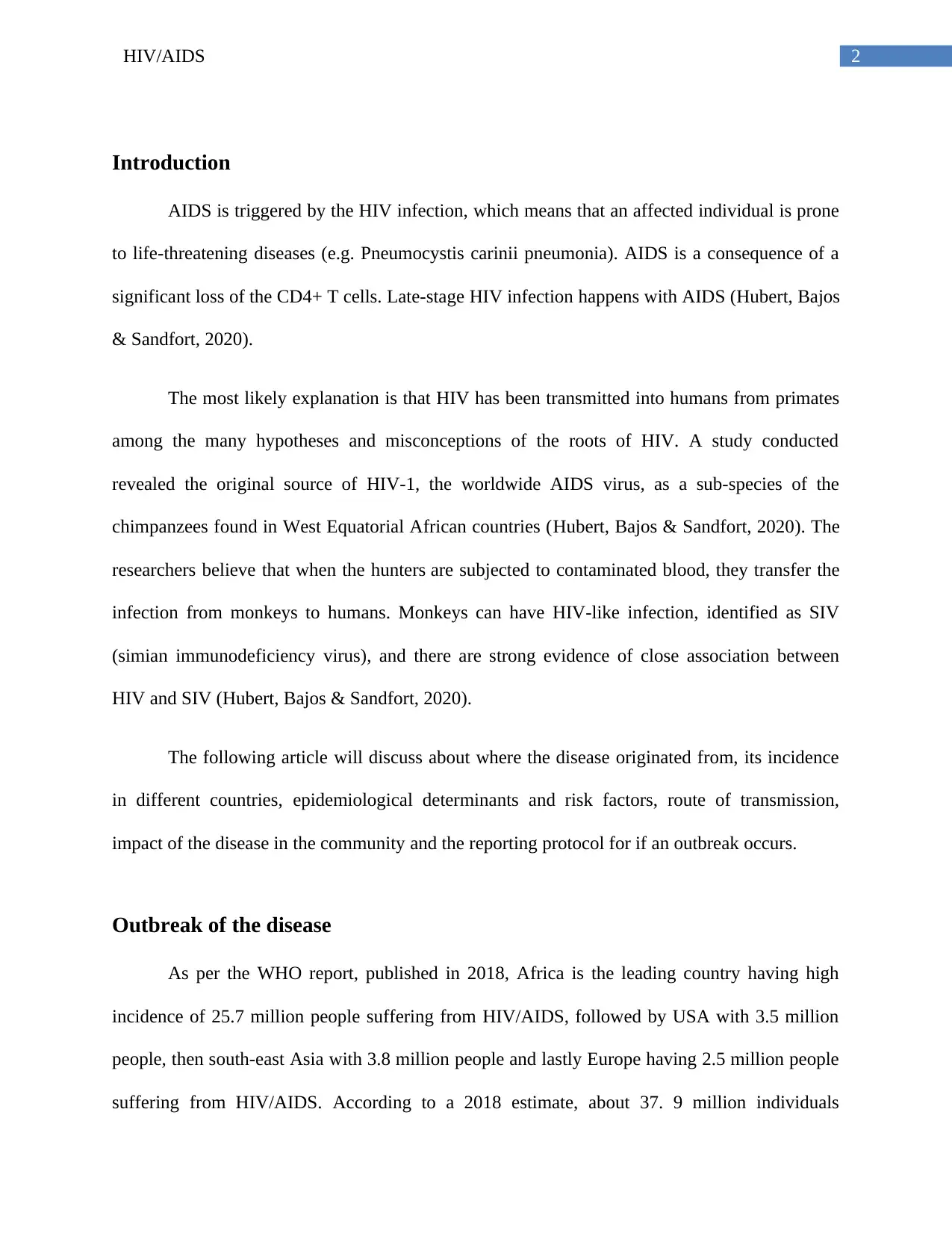
2HIV/AIDS
Introduction
AIDS is triggered by the HIV infection, which means that an affected individual is prone
to life-threatening diseases (e.g. Pneumocystis carinii pneumonia). AIDS is a consequence of a
significant loss of the CD4+ T cells. Late-stage HIV infection happens with AIDS (Hubert, Bajos
& Sandfort, 2020).
The most likely explanation is that HIV has been transmitted into humans from primates
among the many hypotheses and misconceptions of the roots of HIV. A study conducted
revealed the original source of HIV-1, the worldwide AIDS virus, as a sub-species of the
chimpanzees found in West Equatorial African countries (Hubert, Bajos & Sandfort, 2020). The
researchers believe that when the hunters are subjected to contaminated blood, they transfer the
infection from monkeys to humans. Monkeys can have HIV-like infection, identified as SIV
(simian immunodeficiency virus), and there are strong evidence of close association between
HIV and SIV (Hubert, Bajos & Sandfort, 2020).
The following article will discuss about where the disease originated from, its incidence
in different countries, epidemiological determinants and risk factors, route of transmission,
impact of the disease in the community and the reporting protocol for if an outbreak occurs.
Outbreak of the disease
As per the WHO report, published in 2018, Africa is the leading country having high
incidence of 25.7 million people suffering from HIV/AIDS, followed by USA with 3.5 million
people, then south-east Asia with 3.8 million people and lastly Europe having 2.5 million people
suffering from HIV/AIDS. According to a 2018 estimate, about 37. 9 million individuals
Introduction
AIDS is triggered by the HIV infection, which means that an affected individual is prone
to life-threatening diseases (e.g. Pneumocystis carinii pneumonia). AIDS is a consequence of a
significant loss of the CD4+ T cells. Late-stage HIV infection happens with AIDS (Hubert, Bajos
& Sandfort, 2020).
The most likely explanation is that HIV has been transmitted into humans from primates
among the many hypotheses and misconceptions of the roots of HIV. A study conducted
revealed the original source of HIV-1, the worldwide AIDS virus, as a sub-species of the
chimpanzees found in West Equatorial African countries (Hubert, Bajos & Sandfort, 2020). The
researchers believe that when the hunters are subjected to contaminated blood, they transfer the
infection from monkeys to humans. Monkeys can have HIV-like infection, identified as SIV
(simian immunodeficiency virus), and there are strong evidence of close association between
HIV and SIV (Hubert, Bajos & Sandfort, 2020).
The following article will discuss about where the disease originated from, its incidence
in different countries, epidemiological determinants and risk factors, route of transmission,
impact of the disease in the community and the reporting protocol for if an outbreak occurs.
Outbreak of the disease
As per the WHO report, published in 2018, Africa is the leading country having high
incidence of 25.7 million people suffering from HIV/AIDS, followed by USA with 3.5 million
people, then south-east Asia with 3.8 million people and lastly Europe having 2.5 million people
suffering from HIV/AIDS. According to a 2018 estimate, about 37. 9 million individuals
⊘ This is a preview!⊘
Do you want full access?
Subscribe today to unlock all pages.

Trusted by 1+ million students worldwide
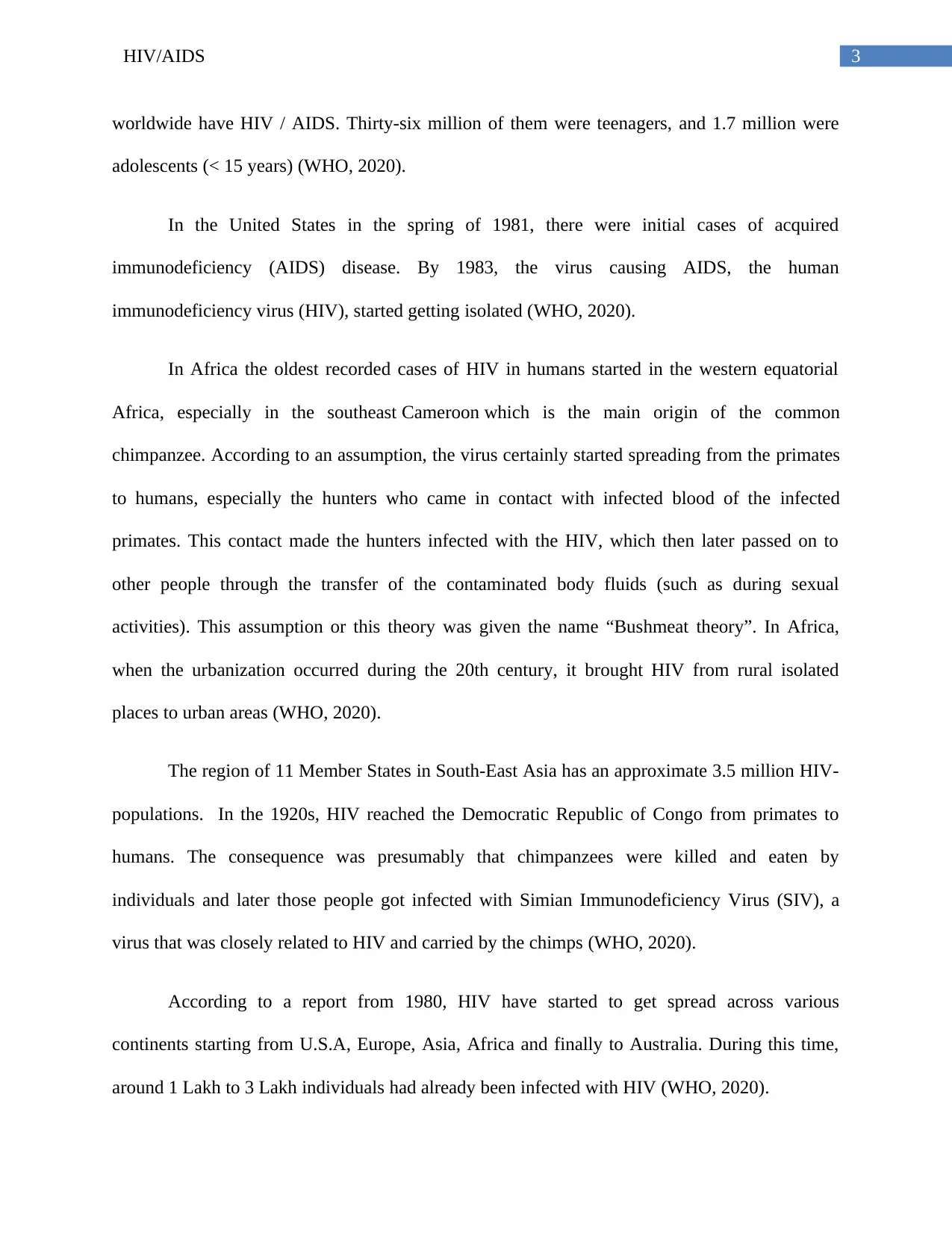
3HIV/AIDS
worldwide have HIV / AIDS. Thirty-six million of them were teenagers, and 1.7 million were
adolescents (< 15 years) (WHO, 2020).
In the United States in the spring of 1981, there were initial cases of acquired
immunodeficiency (AIDS) disease. By 1983, the virus causing AIDS, the human
immunodeficiency virus (HIV), started getting isolated (WHO, 2020).
In Africa the oldest recorded cases of HIV in humans started in the western equatorial
Africa, especially in the southeast Cameroon which is the main origin of the common
chimpanzee. According to an assumption, the virus certainly started spreading from the primates
to humans, especially the hunters who came in contact with infected blood of the infected
primates. This contact made the hunters infected with the HIV, which then later passed on to
other people through the transfer of the contaminated body fluids (such as during sexual
activities). This assumption or this theory was given the name “Bushmeat theory”. In Africa,
when the urbanization occurred during the 20th century, it brought HIV from rural isolated
places to urban areas (WHO, 2020).
The region of 11 Member States in South-East Asia has an approximate 3.5 million HIV-
populations. In the 1920s, HIV reached the Democratic Republic of Congo from primates to
humans. The consequence was presumably that chimpanzees were killed and eaten by
individuals and later those people got infected with Simian Immunodeficiency Virus (SIV), a
virus that was closely related to HIV and carried by the chimps (WHO, 2020).
According to a report from 1980, HIV have started to get spread across various
continents starting from U.S.A, Europe, Asia, Africa and finally to Australia. During this time,
around 1 Lakh to 3 Lakh individuals had already been infected with HIV (WHO, 2020).
worldwide have HIV / AIDS. Thirty-six million of them were teenagers, and 1.7 million were
adolescents (< 15 years) (WHO, 2020).
In the United States in the spring of 1981, there were initial cases of acquired
immunodeficiency (AIDS) disease. By 1983, the virus causing AIDS, the human
immunodeficiency virus (HIV), started getting isolated (WHO, 2020).
In Africa the oldest recorded cases of HIV in humans started in the western equatorial
Africa, especially in the southeast Cameroon which is the main origin of the common
chimpanzee. According to an assumption, the virus certainly started spreading from the primates
to humans, especially the hunters who came in contact with infected blood of the infected
primates. This contact made the hunters infected with the HIV, which then later passed on to
other people through the transfer of the contaminated body fluids (such as during sexual
activities). This assumption or this theory was given the name “Bushmeat theory”. In Africa,
when the urbanization occurred during the 20th century, it brought HIV from rural isolated
places to urban areas (WHO, 2020).
The region of 11 Member States in South-East Asia has an approximate 3.5 million HIV-
populations. In the 1920s, HIV reached the Democratic Republic of Congo from primates to
humans. The consequence was presumably that chimpanzees were killed and eaten by
individuals and later those people got infected with Simian Immunodeficiency Virus (SIV), a
virus that was closely related to HIV and carried by the chimps (WHO, 2020).
According to a report from 1980, HIV have started to get spread across various
continents starting from U.S.A, Europe, Asia, Africa and finally to Australia. During this time,
around 1 Lakh to 3 Lakh individuals had already been infected with HIV (WHO, 2020).
Paraphrase This Document
Need a fresh take? Get an instant paraphrase of this document with our AI Paraphraser
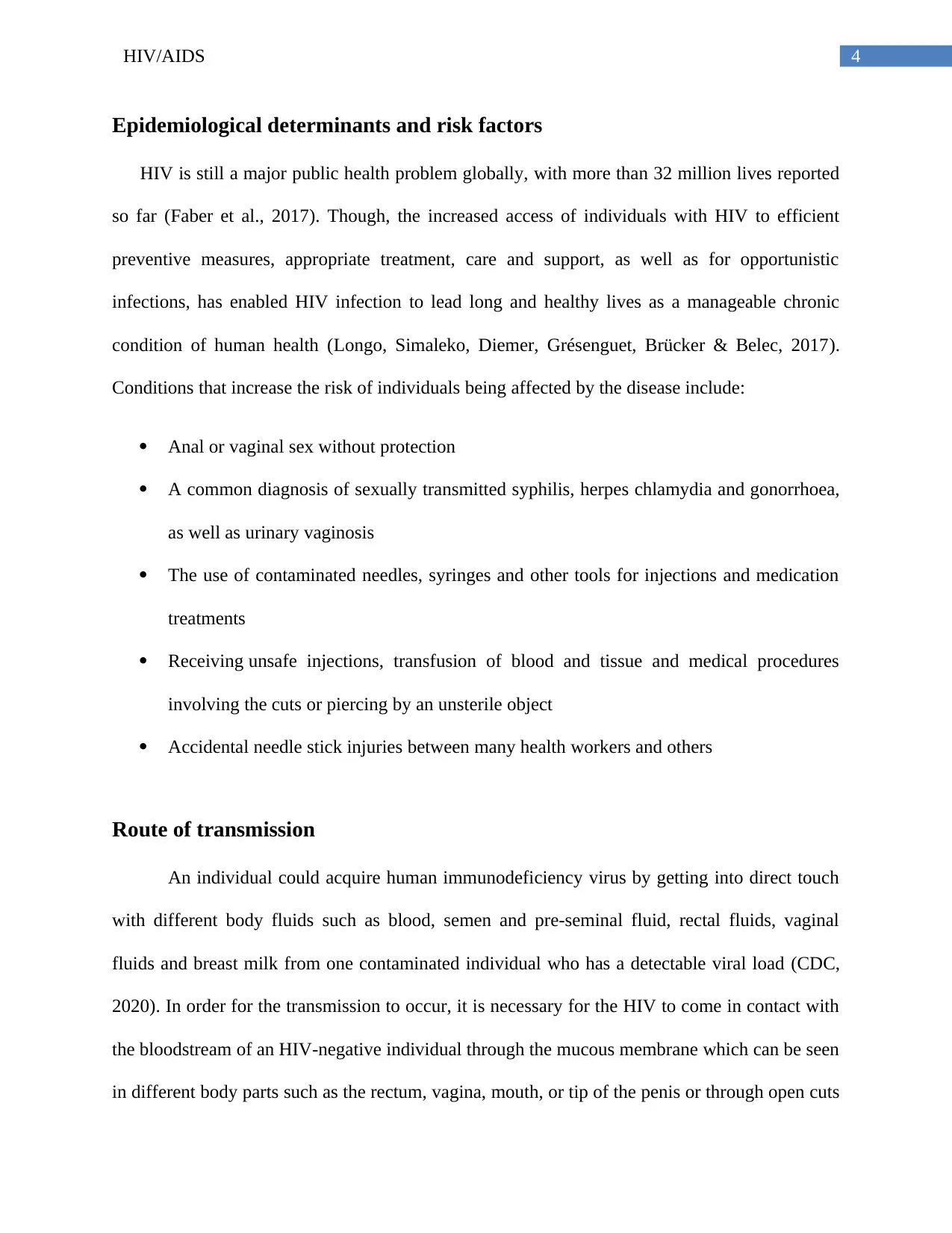
4HIV/AIDS
Epidemiological determinants and risk factors
HIV is still a major public health problem globally, with more than 32 million lives reported
so far (Faber et al., 2017). Though, the increased access of individuals with HIV to efficient
preventive measures, appropriate treatment, care and support, as well as for opportunistic
infections, has enabled HIV infection to lead long and healthy lives as a manageable chronic
condition of human health (Longo, Simaleko, Diemer, Grésenguet, Brücker & Belec, 2017).
Conditions that increase the risk of individuals being affected by the disease include:
Anal or vaginal sex without protection
A common diagnosis of sexually transmitted syphilis, herpes chlamydia and gonorrhoea,
as well as urinary vaginosis
The use of contaminated needles, syringes and other tools for injections and medication
treatments
Receiving unsafe injections, transfusion of blood and tissue and medical procedures
involving the cuts or piercing by an unsterile object
Accidental needle stick injuries between many health workers and others
Route of transmission
An individual could acquire human immunodeficiency virus by getting into direct touch
with different body fluids such as blood, semen and pre-seminal fluid, rectal fluids, vaginal
fluids and breast milk from one contaminated individual who has a detectable viral load (CDC,
2020). In order for the transmission to occur, it is necessary for the HIV to come in contact with
the bloodstream of an HIV-negative individual through the mucous membrane which can be seen
in different body parts such as the rectum, vagina, mouth, or tip of the penis or through open cuts
Epidemiological determinants and risk factors
HIV is still a major public health problem globally, with more than 32 million lives reported
so far (Faber et al., 2017). Though, the increased access of individuals with HIV to efficient
preventive measures, appropriate treatment, care and support, as well as for opportunistic
infections, has enabled HIV infection to lead long and healthy lives as a manageable chronic
condition of human health (Longo, Simaleko, Diemer, Grésenguet, Brücker & Belec, 2017).
Conditions that increase the risk of individuals being affected by the disease include:
Anal or vaginal sex without protection
A common diagnosis of sexually transmitted syphilis, herpes chlamydia and gonorrhoea,
as well as urinary vaginosis
The use of contaminated needles, syringes and other tools for injections and medication
treatments
Receiving unsafe injections, transfusion of blood and tissue and medical procedures
involving the cuts or piercing by an unsterile object
Accidental needle stick injuries between many health workers and others
Route of transmission
An individual could acquire human immunodeficiency virus by getting into direct touch
with different body fluids such as blood, semen and pre-seminal fluid, rectal fluids, vaginal
fluids and breast milk from one contaminated individual who has a detectable viral load (CDC,
2020). In order for the transmission to occur, it is necessary for the HIV to come in contact with
the bloodstream of an HIV-negative individual through the mucous membrane which can be seen
in different body parts such as the rectum, vagina, mouth, or tip of the penis or through open cuts
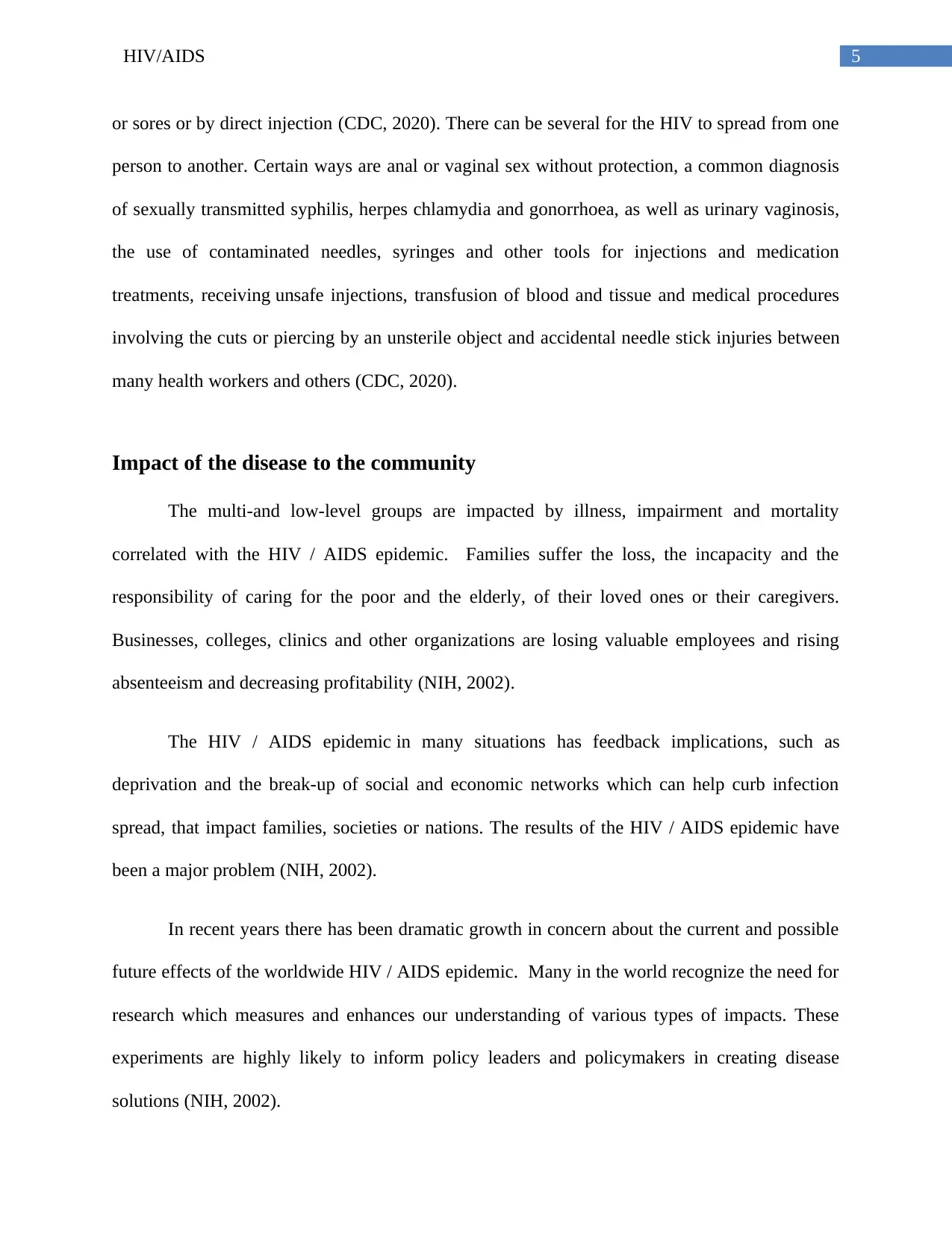
5HIV/AIDS
or sores or by direct injection (CDC, 2020). There can be several for the HIV to spread from one
person to another. Certain ways are anal or vaginal sex without protection, a common diagnosis
of sexually transmitted syphilis, herpes chlamydia and gonorrhoea, as well as urinary vaginosis,
the use of contaminated needles, syringes and other tools for injections and medication
treatments, receiving unsafe injections, transfusion of blood and tissue and medical procedures
involving the cuts or piercing by an unsterile object and accidental needle stick injuries between
many health workers and others (CDC, 2020).
Impact of the disease to the community
The multi-and low-level groups are impacted by illness, impairment and mortality
correlated with the HIV / AIDS epidemic. Families suffer the loss, the incapacity and the
responsibility of caring for the poor and the elderly, of their loved ones or their caregivers.
Businesses, colleges, clinics and other organizations are losing valuable employees and rising
absenteeism and decreasing profitability (NIH, 2002).
The HIV / AIDS epidemic in many situations has feedback implications, such as
deprivation and the break-up of social and economic networks which can help curb infection
spread, that impact families, societies or nations. The results of the HIV / AIDS epidemic have
been a major problem (NIH, 2002).
In recent years there has been dramatic growth in concern about the current and possible
future effects of the worldwide HIV / AIDS epidemic. Many in the world recognize the need for
research which measures and enhances our understanding of various types of impacts. These
experiments are highly likely to inform policy leaders and policymakers in creating disease
solutions (NIH, 2002).
or sores or by direct injection (CDC, 2020). There can be several for the HIV to spread from one
person to another. Certain ways are anal or vaginal sex without protection, a common diagnosis
of sexually transmitted syphilis, herpes chlamydia and gonorrhoea, as well as urinary vaginosis,
the use of contaminated needles, syringes and other tools for injections and medication
treatments, receiving unsafe injections, transfusion of blood and tissue and medical procedures
involving the cuts or piercing by an unsterile object and accidental needle stick injuries between
many health workers and others (CDC, 2020).
Impact of the disease to the community
The multi-and low-level groups are impacted by illness, impairment and mortality
correlated with the HIV / AIDS epidemic. Families suffer the loss, the incapacity and the
responsibility of caring for the poor and the elderly, of their loved ones or their caregivers.
Businesses, colleges, clinics and other organizations are losing valuable employees and rising
absenteeism and decreasing profitability (NIH, 2002).
The HIV / AIDS epidemic in many situations has feedback implications, such as
deprivation and the break-up of social and economic networks which can help curb infection
spread, that impact families, societies or nations. The results of the HIV / AIDS epidemic have
been a major problem (NIH, 2002).
In recent years there has been dramatic growth in concern about the current and possible
future effects of the worldwide HIV / AIDS epidemic. Many in the world recognize the need for
research which measures and enhances our understanding of various types of impacts. These
experiments are highly likely to inform policy leaders and policymakers in creating disease
solutions (NIH, 2002).
⊘ This is a preview!⊘
Do you want full access?
Subscribe today to unlock all pages.

Trusted by 1+ million students worldwide
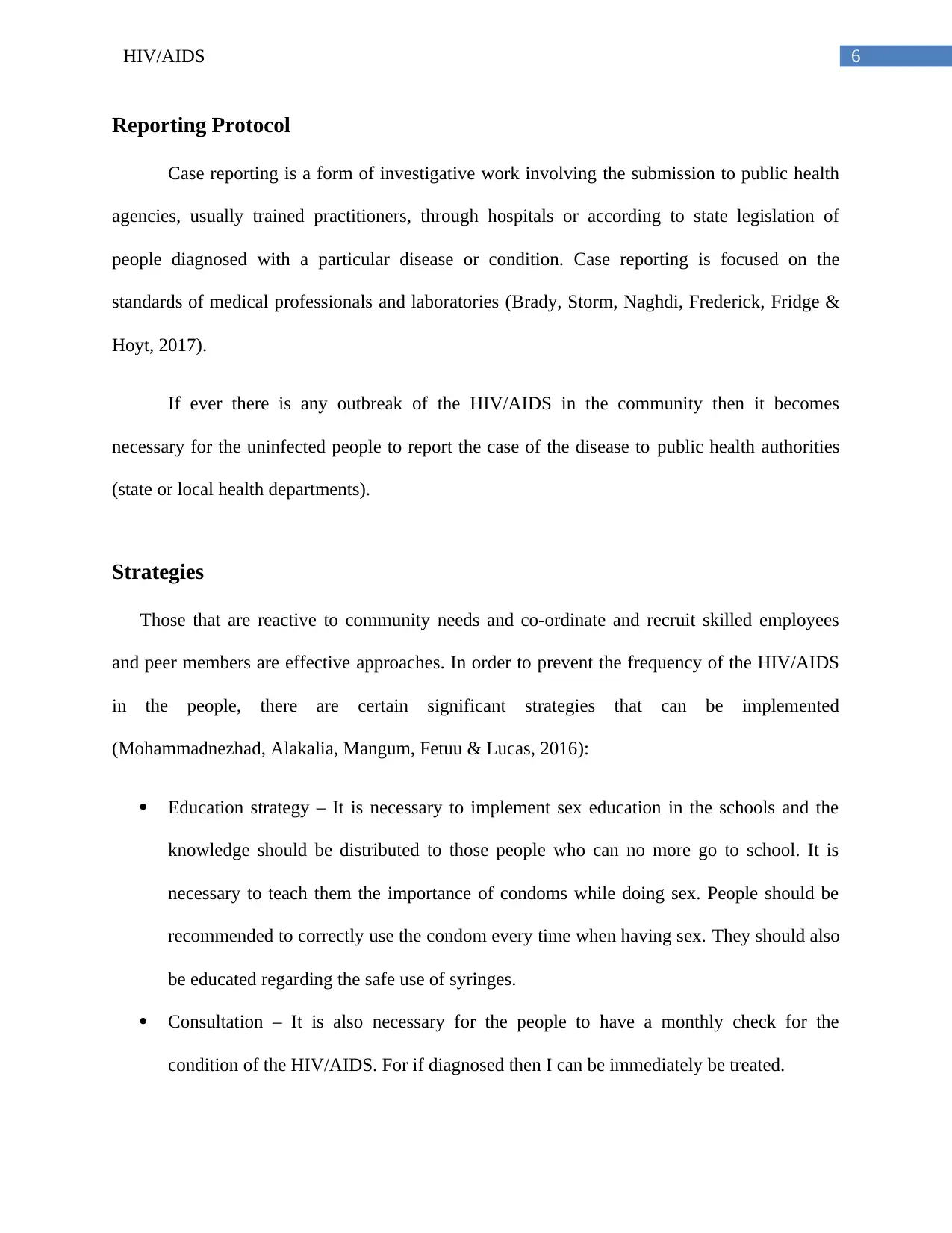
6HIV/AIDS
Reporting Protocol
Case reporting is a form of investigative work involving the submission to public health
agencies, usually trained practitioners, through hospitals or according to state legislation of
people diagnosed with a particular disease or condition. Case reporting is focused on the
standards of medical professionals and laboratories (Brady, Storm, Naghdi, Frederick, Fridge &
Hoyt, 2017).
If ever there is any outbreak of the HIV/AIDS in the community then it becomes
necessary for the uninfected people to report the case of the disease to public health authorities
(state or local health departments).
Strategies
Those that are reactive to community needs and co-ordinate and recruit skilled employees
and peer members are effective approaches. In order to prevent the frequency of the HIV/AIDS
in the people, there are certain significant strategies that can be implemented
(Mohammadnezhad, Alakalia, Mangum, Fetuu & Lucas, 2016):
Education strategy – It is necessary to implement sex education in the schools and the
knowledge should be distributed to those people who can no more go to school. It is
necessary to teach them the importance of condoms while doing sex. People should be
recommended to correctly use the condom every time when having sex. They should also
be educated regarding the safe use of syringes.
Consultation – It is also necessary for the people to have a monthly check for the
condition of the HIV/AIDS. For if diagnosed then I can be immediately be treated.
Reporting Protocol
Case reporting is a form of investigative work involving the submission to public health
agencies, usually trained practitioners, through hospitals or according to state legislation of
people diagnosed with a particular disease or condition. Case reporting is focused on the
standards of medical professionals and laboratories (Brady, Storm, Naghdi, Frederick, Fridge &
Hoyt, 2017).
If ever there is any outbreak of the HIV/AIDS in the community then it becomes
necessary for the uninfected people to report the case of the disease to public health authorities
(state or local health departments).
Strategies
Those that are reactive to community needs and co-ordinate and recruit skilled employees
and peer members are effective approaches. In order to prevent the frequency of the HIV/AIDS
in the people, there are certain significant strategies that can be implemented
(Mohammadnezhad, Alakalia, Mangum, Fetuu & Lucas, 2016):
Education strategy – It is necessary to implement sex education in the schools and the
knowledge should be distributed to those people who can no more go to school. It is
necessary to teach them the importance of condoms while doing sex. People should be
recommended to correctly use the condom every time when having sex. They should also
be educated regarding the safe use of syringes.
Consultation – It is also necessary for the people to have a monthly check for the
condition of the HIV/AIDS. For if diagnosed then I can be immediately be treated.
Paraphrase This Document
Need a fresh take? Get an instant paraphrase of this document with our AI Paraphraser
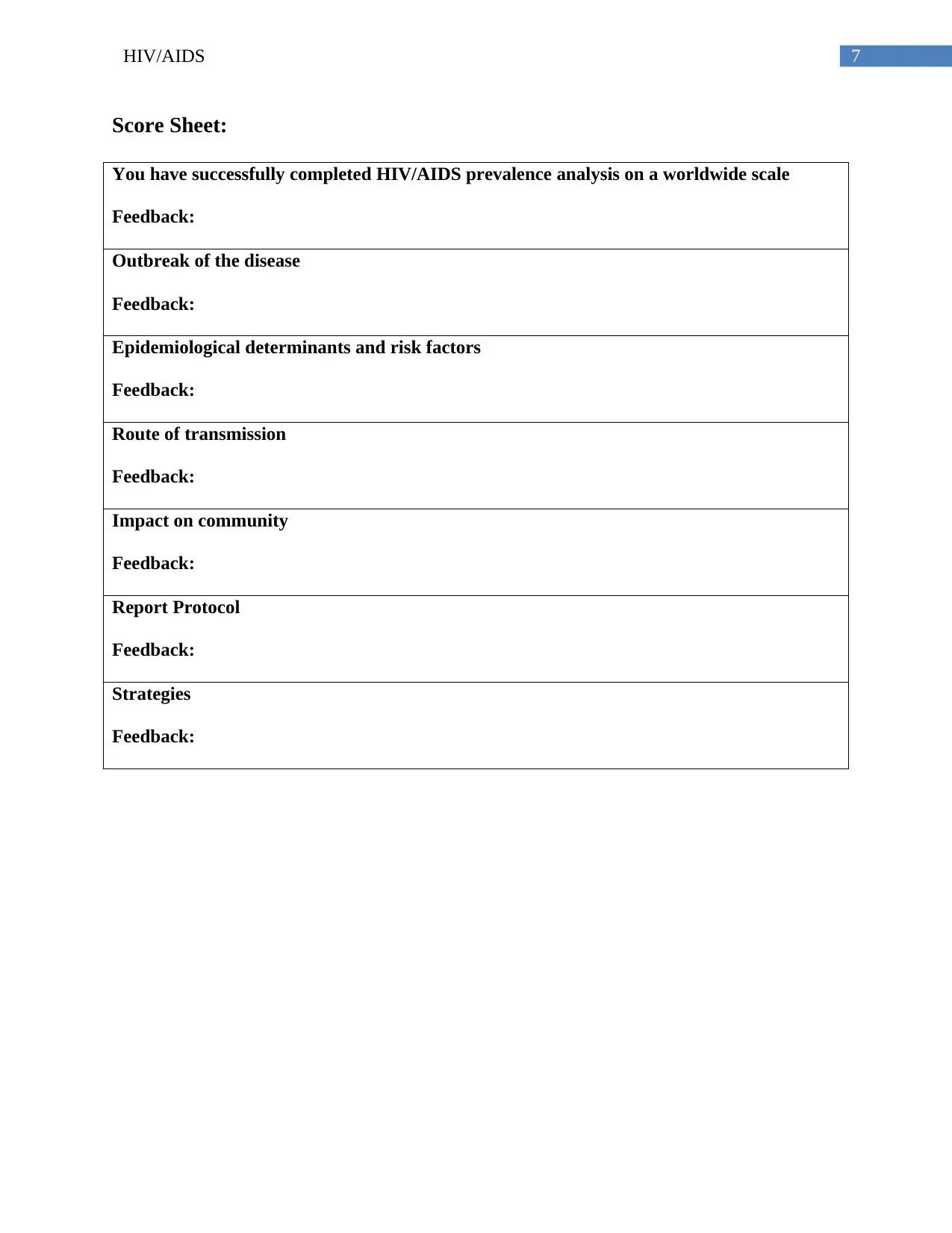
7HIV/AIDS
Score Sheet:
You have successfully completed HIV/AIDS prevalence analysis on a worldwide scale
Feedback:
Outbreak of the disease
Feedback:
Epidemiological determinants and risk factors
Feedback:
Route of transmission
Feedback:
Impact on community
Feedback:
Report Protocol
Feedback:
Strategies
Feedback:
Score Sheet:
You have successfully completed HIV/AIDS prevalence analysis on a worldwide scale
Feedback:
Outbreak of the disease
Feedback:
Epidemiological determinants and risk factors
Feedback:
Route of transmission
Feedback:
Impact on community
Feedback:
Report Protocol
Feedback:
Strategies
Feedback:
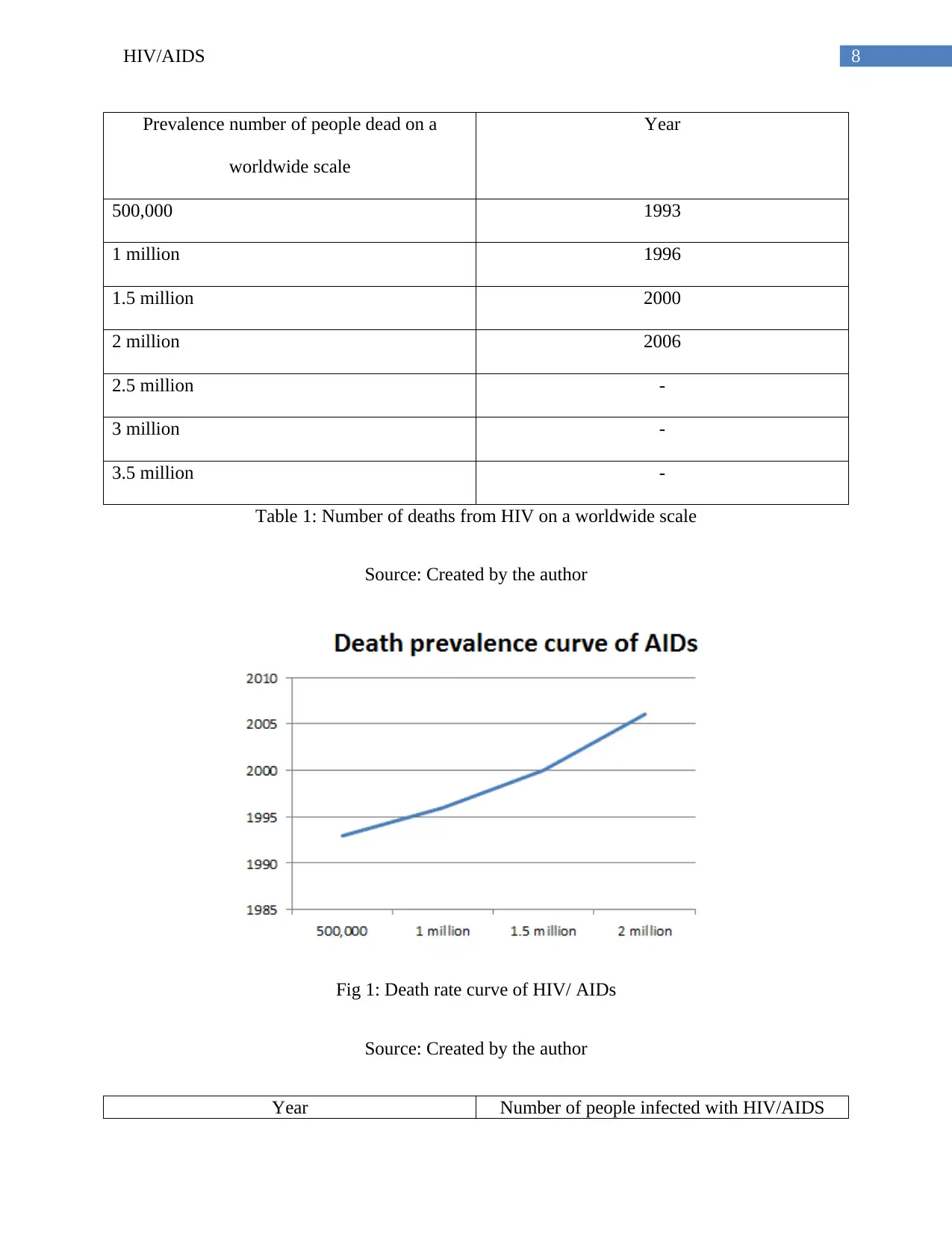
8HIV/AIDS
Prevalence number of people dead on a
worldwide scale
Year
500,000 1993
1 million 1996
1.5 million 2000
2 million 2006
2.5 million -
3 million -
3.5 million -
Table 1: Number of deaths from HIV on a worldwide scale
Source: Created by the author
Fig 1: Death rate curve of HIV/ AIDs
Source: Created by the author
Year Number of people infected with HIV/AIDS
Prevalence number of people dead on a
worldwide scale
Year
500,000 1993
1 million 1996
1.5 million 2000
2 million 2006
2.5 million -
3 million -
3.5 million -
Table 1: Number of deaths from HIV on a worldwide scale
Source: Created by the author
Fig 1: Death rate curve of HIV/ AIDs
Source: Created by the author
Year Number of people infected with HIV/AIDS
⊘ This is a preview!⊘
Do you want full access?
Subscribe today to unlock all pages.

Trusted by 1+ million students worldwide
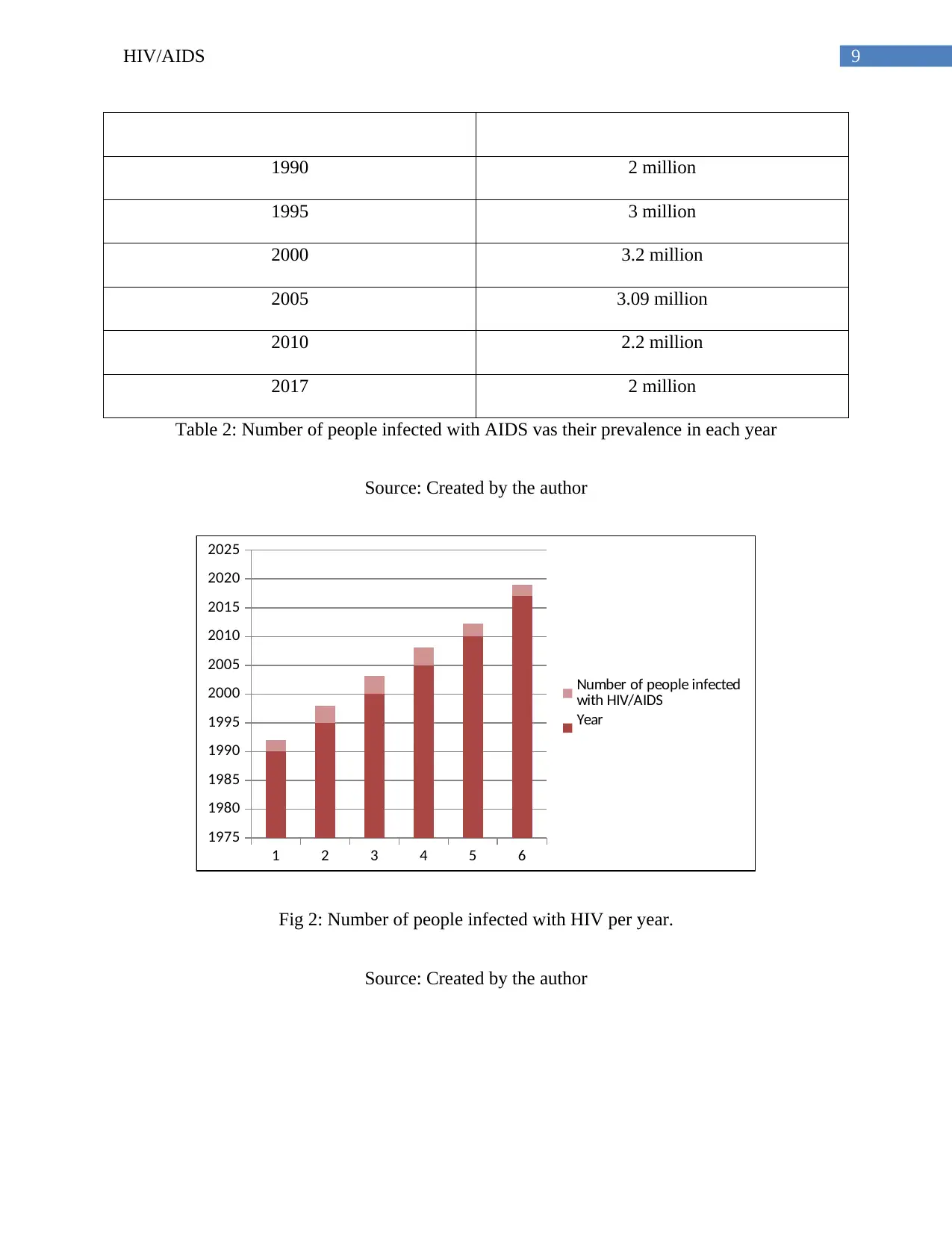
9HIV/AIDS
1990 2 million
1995 3 million
2000 3.2 million
2005 3.09 million
2010 2.2 million
2017 2 million
Table 2: Number of people infected with AIDS vas their prevalence in each year
Source: Created by the author
1 2 3 4 5 6
1975
1980
1985
1990
1995
2000
2005
2010
2015
2020
2025
Number of people infected
with HIV/AIDS
Year
Fig 2: Number of people infected with HIV per year.
Source: Created by the author
1990 2 million
1995 3 million
2000 3.2 million
2005 3.09 million
2010 2.2 million
2017 2 million
Table 2: Number of people infected with AIDS vas their prevalence in each year
Source: Created by the author
1 2 3 4 5 6
1975
1980
1985
1990
1995
2000
2005
2010
2015
2020
2025
Number of people infected
with HIV/AIDS
Year
Fig 2: Number of people infected with HIV per year.
Source: Created by the author
Paraphrase This Document
Need a fresh take? Get an instant paraphrase of this document with our AI Paraphraser
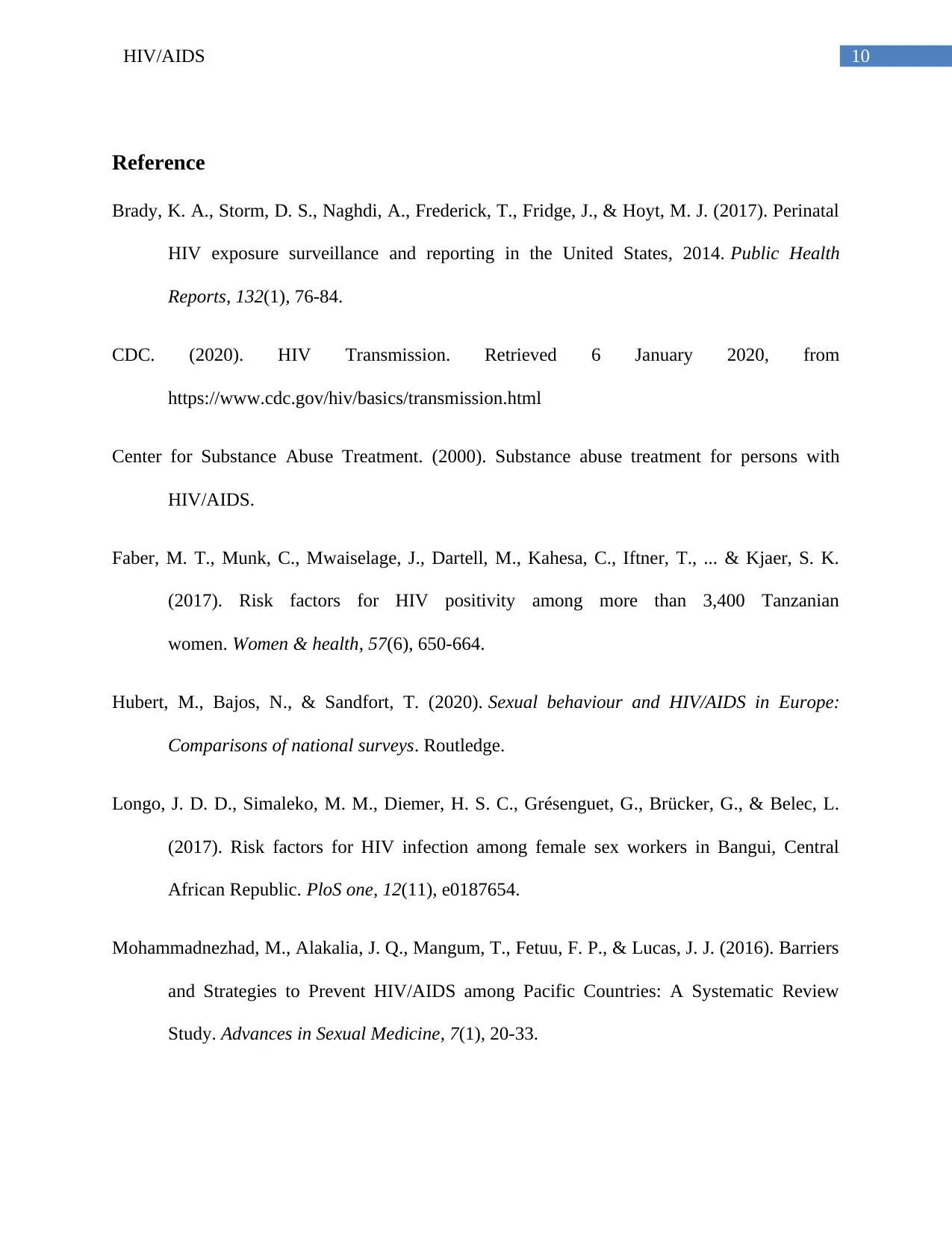
10HIV/AIDS
Reference
Brady, K. A., Storm, D. S., Naghdi, A., Frederick, T., Fridge, J., & Hoyt, M. J. (2017). Perinatal
HIV exposure surveillance and reporting in the United States, 2014. Public Health
Reports, 132(1), 76-84.
CDC. (2020). HIV Transmission. Retrieved 6 January 2020, from
https://www.cdc.gov/hiv/basics/transmission.html
Center for Substance Abuse Treatment. (2000). Substance abuse treatment for persons with
HIV/AIDS.
Faber, M. T., Munk, C., Mwaiselage, J., Dartell, M., Kahesa, C., Iftner, T., ... & Kjaer, S. K.
(2017). Risk factors for HIV positivity among more than 3,400 Tanzanian
women. Women & health, 57(6), 650-664.
Hubert, M., Bajos, N., & Sandfort, T. (2020). Sexual behaviour and HIV/AIDS in Europe:
Comparisons of national surveys. Routledge.
Longo, J. D. D., Simaleko, M. M., Diemer, H. S. C., Grésenguet, G., Brücker, G., & Belec, L.
(2017). Risk factors for HIV infection among female sex workers in Bangui, Central
African Republic. PloS one, 12(11), e0187654.
Mohammadnezhad, M., Alakalia, J. Q., Mangum, T., Fetuu, F. P., & Lucas, J. J. (2016). Barriers
and Strategies to Prevent HIV/AIDS among Pacific Countries: A Systematic Review
Study. Advances in Sexual Medicine, 7(1), 20-33.
Reference
Brady, K. A., Storm, D. S., Naghdi, A., Frederick, T., Fridge, J., & Hoyt, M. J. (2017). Perinatal
HIV exposure surveillance and reporting in the United States, 2014. Public Health
Reports, 132(1), 76-84.
CDC. (2020). HIV Transmission. Retrieved 6 January 2020, from
https://www.cdc.gov/hiv/basics/transmission.html
Center for Substance Abuse Treatment. (2000). Substance abuse treatment for persons with
HIV/AIDS.
Faber, M. T., Munk, C., Mwaiselage, J., Dartell, M., Kahesa, C., Iftner, T., ... & Kjaer, S. K.
(2017). Risk factors for HIV positivity among more than 3,400 Tanzanian
women. Women & health, 57(6), 650-664.
Hubert, M., Bajos, N., & Sandfort, T. (2020). Sexual behaviour and HIV/AIDS in Europe:
Comparisons of national surveys. Routledge.
Longo, J. D. D., Simaleko, M. M., Diemer, H. S. C., Grésenguet, G., Brücker, G., & Belec, L.
(2017). Risk factors for HIV infection among female sex workers in Bangui, Central
African Republic. PloS one, 12(11), e0187654.
Mohammadnezhad, M., Alakalia, J. Q., Mangum, T., Fetuu, F. P., & Lucas, J. J. (2016). Barriers
and Strategies to Prevent HIV/AIDS among Pacific Countries: A Systematic Review
Study. Advances in Sexual Medicine, 7(1), 20-33.

11HIV/AIDS
NIH. (2002). NIH Guide: SOCIAL AND STRUCTURAL IMPACT OF HIV/AIDS. Retrieved 6
January 2020, from https://grants.nih.gov/grants/guide/pa-files/PA-03-027.html
WHO. (2020). HIV/AIDS. Retrieved 5 January 2020, from https://www.who.int/gho/hiv/en/
NIH. (2002). NIH Guide: SOCIAL AND STRUCTURAL IMPACT OF HIV/AIDS. Retrieved 6
January 2020, from https://grants.nih.gov/grants/guide/pa-files/PA-03-027.html
WHO. (2020). HIV/AIDS. Retrieved 5 January 2020, from https://www.who.int/gho/hiv/en/
⊘ This is a preview!⊘
Do you want full access?
Subscribe today to unlock all pages.

Trusted by 1+ million students worldwide
1 out of 12
Related Documents
Your All-in-One AI-Powered Toolkit for Academic Success.
+13062052269
info@desklib.com
Available 24*7 on WhatsApp / Email
![[object Object]](/_next/static/media/star-bottom.7253800d.svg)
Unlock your academic potential
Copyright © 2020–2025 A2Z Services. All Rights Reserved. Developed and managed by ZUCOL.





